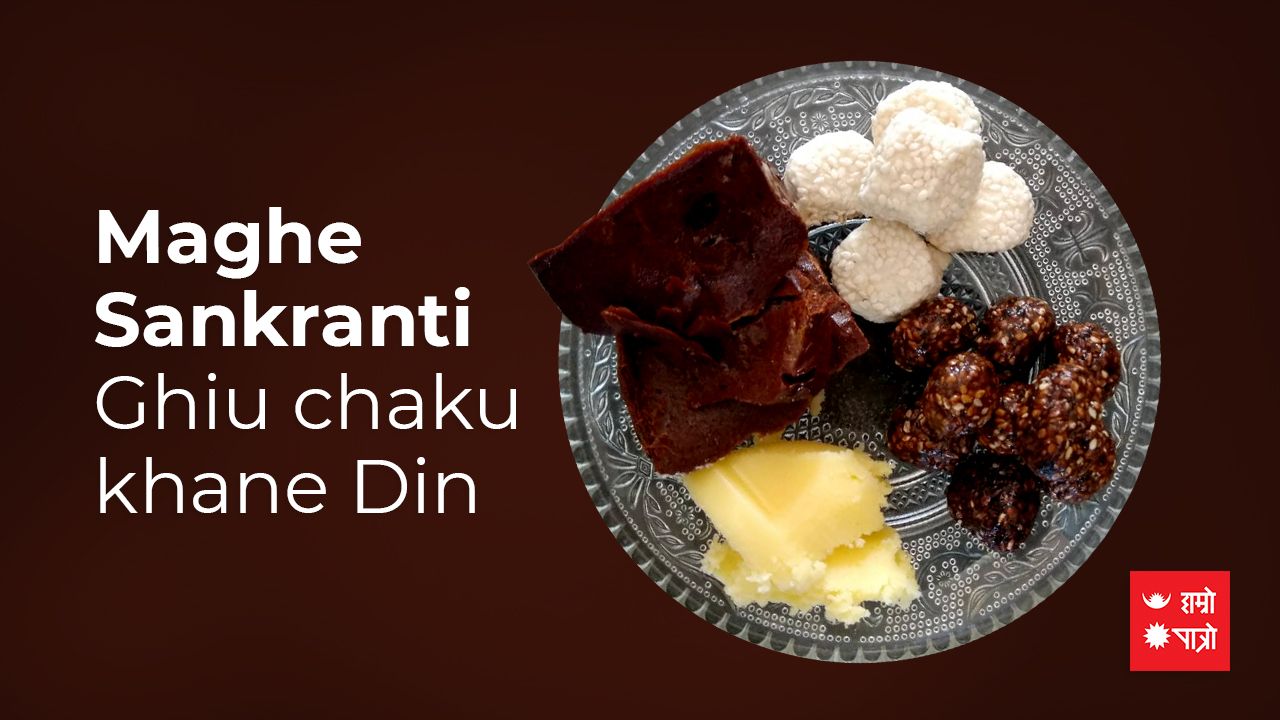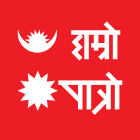Upcomming Events
-
29MangsirSafala Ekadashi Vrata tomorrow
-
1PaushDhanu Sankranti 2 days remaning
-
2PaushPradosh Vrata 3 days remaning
-
3PaushInternational Immigrants Day 4 days remaning
-
5PaushTol Lhosar 6 days remaning
-
6PaushWorld Meditation Day 7 days remaning
-
10PaushChristmas 11 days remaning
-
13PaushGorakhkali Puja 14 days remaning
-
15PaushTamu Lhosar/Kavi Siromani Lekhnath Jayanti/Putrada Ekadashi Vrata 16 days remaning
-
17PaushNew Year 2026/Pradosh Vrata/Topi Day/Poshak Day 18 days remaning
-
19PaushSri Swasthani Vrata Katha Prarambha/Maagh Snan/Poornima Vrata 20 days remaning
-
21PaushGuru Gobinda Singh Jayanti 22 days remaning
-
23PaushAraniko Smriti Day 24 days remaning
-
24PaushNepal Astrology Council Establishment Day 25 days remaning
-
27PaushPrithivi Jayanti/Rashtriya Ekata Diwas/Gorakhkali Puja 28 days remaning
-
29PaushNational Bhakka Day 30 days remaning
-
30PaushShattila Ekadashi 31 days remaning
-
1MaghMakar Sankranti/Ghiu chaku khane Din/Uttarayan Arambha 32 days remaning
-
2MaghNational Earthquake Safety Day/Pradosh Vrata 33 days remaning
-
5MaghSonam Lhochhar/Shree Ballav Jayanti 36 days remaning
-
8MaghTilkunda Chauthi 39 days remaning
-
9MaghBasanta Panchami vrata/Saraswati Pooja 40 days remaning
-
10MaghSkanda Sasti/Achala Saptami/International Day of Education 41 days remaning
-
11MaghGorakhkali Puja/World Leprosy Day 42 days remaning
-
12MaghInternational Custom Day 43 days remaning
-
13MaghDron Nawami 44 days remaning
-
15MaghBhima Ekadashi Vrata 46 days remaning
-
16MaghSahid Diwas/Pradosh Vrata 47 days remaning
-
18MaghShree Swasthani Brata Samapti/Poornima Wrata 49 days remaning
-
19MaghWorld Wetlands Day 50 days remaning
-
21MaghWorld Cancer Day 52 days remaning
-
25MaghRavisaptami Vrata 56 days remaning
-
26MaghGorakhkali Puja 57 days remaning
-
28MaghInternational Day of Women and Girls in Science/Safer Internet Day 59 days remaning
-
1FalgunKumbha Sankranti/Bijaya Ekadashi Vrata/World Radio Day 61 days remaning
-
2FalgunShani Pradosh Vrata/Valentine's Day 62 days remaning
-
3FalgunMaha-Shivaratri / Army Day/Silachahre Puja 63 days remaning
-
6FalgunGyalpo Lhosar 66 days remaning
-
7FalgunPrajatantra Diwas / Election Day 67 days remaning
-
8FalgunWorld Day of Social Justice 68 days remaning
Jyotish
-
Jyotish Narayan Prasad Bhandariज्योतिषका उप-प्राध्यापक (lecturer of A...
-
 Jyotish Mukunda Sharmaस्वाध्याय, सत्सङ्ग र सदाचारजस�...
Jyotish Mukunda Sharmaस्वाध्याय, सत्सङ्ग र सदाचारजस�...
-
Jyotish Vaman Sapkotaशिक्षा - व्याकरणाचार्य, पौरोही...
-
Jyotish Pandit Mukunda Nepalज्योतिष पण्डित मुकुन्द नेपाल�...
-
Jyotish Mohan Ghimireसम्पुर्णानन्द संस्कृत विश्वव...
-
Jyotish Damodar Poudelनेपाल संस्कृत विश्व बिद्यालय�...
-
Jyotish Amrit Paudelवाराणसीकै सम्पूर्णानन्द संस्...
-
Jyotish Purushottam Ghimireनेपाल संस्कृत विश्वविद्यालय, �...
-
Jyotish Smarika Acharyaबाल्मीकि बिद्यापिठ बाट ज्योत�...
-
Jyotish Krishna Prasad Bhandariउपप्राध्यापक (Asst. professor of Sanskrit) नेपा�...
-
 Jyotish Dharmendra Krishna Paudelशास्त्री धर्मेन्द्र कृष्ण पौ�...
Jyotish Dharmendra Krishna Paudelशास्त्री धर्मेन्द्र कृष्ण पौ�...
-
Jyotish Dipendra Khatiwadaसम्पुर्णानन्द संस्कृत बिश्वब...
-
Jyotish Narayan Prasad Gautamगुरुकुल शिक्षा प्रणालीबाट ज्�...
-
 Jyotish Kuresh Pandey११ वर्षको अनुभवसहित विभिन्न ध�...
Jyotish Kuresh Pandey११ वर्षको अनुभवसहित विभिन्न ध�...
-
Jyotish Deepak Prasad Kafleसम्पूर्णानन्द संस्कृत विश्वव...
-
Jyotish Damodar Kaushikज्योतिष र व्याकरण विषयमा आचार�...
-
Jyotish Ghanashyam Pokharelनेपाल संस्कृत विश्वविद्यालयब...
-
Jyotish Khageshwor Subediगुरुकुल पद्दति बाट ज्योतिषीय �...
-
Acharya Choodamani Pathakसम्पूर्णानन्दसंस्कृत विश्वव�...
-
Jyotish Dr. Janak Bhattaविगत ३५ वर्षदेखि कुण्डली निर्�...
-
Jyotish Khagendra Subediसम्पूर्णानंद संस्कृत विश्ववि...
Hororscope
पुष शुक्ल त्रयोदशी
Maghe Sakranti | Uttarayan Aramva | Makar Snan aramva

After autumn leaves disintegrate from tree branches and land on the ground! Seasons passed away yet the urge of re-growing is alive. Regrowing for the human civilization and being, re growing for the planet and welfare, and re-growing to combat the virus and adversities.
Welcome to the Maghe Sakranti of the year 2022 Ad and 2078 BS. This year is passing in hiding and seek, inside the home and outside in masks, sanitizers have completely changed the colors of our hands and the terror of this invisible virus prevails. People are so afraid of new variants such as omicron and Delta and recently the government has closed the schools for time being. May these things be normal sooner and my smile is on each face.
May this Maghe Sakranti transform the situation, today the Sun is changing its direction from Dhanu Rashi to Makar Rashi so this particular day is also called Makar Sakranti.
Today is Maghe Sakranti, the first day of the month of Magh, an important month of mid-winter. Today the Sun enters Capricorn from Sagittarius and this day is celebrated as Maghe Sakranti, Tiluwa Sakranti, or Makar Sakranti or Maghi with its characteristics and cultural significance.
Sesame has a special significance in Sanatan Sanskar, whether it is for home chanting as a charu or for worship and charity or any patriarchal and good deeds, sesame is indispensable. Today, it is famous for sesame laddu. Laddu made by frying sesame seeds and covering them in sakhkar is a special dish of today. That is why Maghe Sakranti is also called Tiluwa Sakranti.
On the other hand, we have read in geography about the North Pole and the South Pole. The direction of the Sun and Earth is also calculated and measured based on the relative positions of those poles. From today the direction of the Sun is moving towards North, It is believed to be decreasing and spring, as well as summer, is increasing. So this day is also called Uttarayan. We will come to that later.
Let's first rejoice Maghi.
Let's talk about the religious and mythological beliefs of this day. In the Mahabharata, Bhishma Pitamah who was lying in the death bed because of the Arjun's arrow, wished for death today. This day is so auspicious for salvation and spiritual gravity, that is why Bhisma who had a boon to make a wish for his death choose this day for ending his life.
Today, there are crowds of pilgrims bathing in various ghats, rivers, and shrines, Devghat of Nawalparasi, Chatara of Sunsari, Kaligandaki bank, Setiveni of Parwat, Bagmati bank of Kathmandu Shankhamul, etc.
In Madhes, Maithil and Tharu communities celebrate this festival with great harmony. In the Tharu community, this day is celebrated almost like New Year in the form of Yale Dugan.
Today, it is believed that the Kirat dynasty invaded the Kathmandu Valley and achieved victory and the same victory celebration is considered to have started as Kirat Samvat.
In the Newar community, Maghe Sankranti is celebrated with the name 'Ghuchaku Salhu'. They make laddu by mixing sesame seeds in Sakhhar and eating and donating it. Today, a historical Makar fair is held in Panauti near Kathmandu Valley, this fair started from the regime of King Mandab.
Maghe Sankranti is also a major festival of the Magar caste in Nepal. Maghe Sankranti has been recognized as the national festival of the Magars. In the Magar community, the archery game is played today. In this festival, the Magars duly worship the daughters and ancestors for three days.
May this Maghi be as sweet as the Til ko laddu, my best wishes.
The descent begins: Uttarayan Aramva
The position of the sun changes twice a year. These two changes are understood as north and south. The time when the Sun appears from Capricorn to Gemini during 6 months is called Uttarayana and the time when the Sun enters from Cancer to Sagittarius is called Dakshinayan.
During the Uttarayan, the path of the Sun's orbit is gradually moving north. According to the scriptures, Uttarayan is considered a symbol of positivity, and Dakshinayan is considered a symbol of negativity. According to the scriptures, 6 months of Uttarayan is one day for the gods and 6 months of Dakshinayan is one night for the gods.
According to mythology, people who die during Uttarayan attain salvation, while those who die during Dakshinayan must be reborn, which is why these two positions of the sun are considered the path to salvation from the human world. During theUttarayan, the days are long and the nights are short. It is considered appropriate to do special auspicious deeds like marriage, house entry, fasting, etc. in Uttarayan. Good luck everyone
Makar Snan aramva
Makar Snan has officially started by burying Lingos (bamboo poles in the bank of Devghat), the confluence of Krishnagandaki and Trishuli rivers. On the eve of Maghe Sankranti, after the bamboo linga is buried in Dobhan, the ritual of Makar Snan officially begins. Since the Sun enters Capricorn from Sagittarius on this day, this day is called Makar Sakranti and the bath starting from today is called Makar bath.
Utmost wishes, the winter is waving goodbyes and summer is all set.
Suyog Dhakal
Upcomming Events
-
29MangsirSafala Ekadashi Vrata tomorrow
-
1PaushDhanu Sankranti 2 days remaning
-
2PaushPradosh Vrata 3 days remaning
-
3PaushInternational Immigrants Day 4 days remaning
-
5PaushTol Lhosar 6 days remaning
-
6PaushWorld Meditation Day 7 days remaning
-
10PaushChristmas 11 days remaning
-
13PaushGorakhkali Puja 14 days remaning
-
15PaushTamu Lhosar/Kavi Siromani Lekhnath Jayanti/Putrada Ekadashi Vrata 16 days remaning
-
17PaushNew Year 2026/Pradosh Vrata/Topi Day/Poshak Day 18 days remaning
-
19PaushSri Swasthani Vrata Katha Prarambha/Maagh Snan/Poornima Vrata 20 days remaning
-
21PaushGuru Gobinda Singh Jayanti 22 days remaning
-
23PaushAraniko Smriti Day 24 days remaning
-
24PaushNepal Astrology Council Establishment Day 25 days remaning
-
27PaushPrithivi Jayanti/Rashtriya Ekata Diwas/Gorakhkali Puja 28 days remaning
-
29PaushNational Bhakka Day 30 days remaning
-
30PaushShattila Ekadashi 31 days remaning
-
1MaghMakar Sankranti/Ghiu chaku khane Din/Uttarayan Arambha 32 days remaning
-
2MaghNational Earthquake Safety Day/Pradosh Vrata 33 days remaning
-
5MaghSonam Lhochhar/Shree Ballav Jayanti 36 days remaning
-
8MaghTilkunda Chauthi 39 days remaning
-
9MaghBasanta Panchami vrata/Saraswati Pooja 40 days remaning
-
10MaghSkanda Sasti/Achala Saptami/International Day of Education 41 days remaning
-
11MaghGorakhkali Puja/World Leprosy Day 42 days remaning
-
12MaghInternational Custom Day 43 days remaning
-
13MaghDron Nawami 44 days remaning
-
15MaghBhima Ekadashi Vrata 46 days remaning
-
16MaghSahid Diwas/Pradosh Vrata 47 days remaning
-
18MaghShree Swasthani Brata Samapti/Poornima Wrata 49 days remaning
-
19MaghWorld Wetlands Day 50 days remaning
-
21MaghWorld Cancer Day 52 days remaning
-
25MaghRavisaptami Vrata 56 days remaning
-
26MaghGorakhkali Puja 57 days remaning
-
28MaghInternational Day of Women and Girls in Science/Safer Internet Day 59 days remaning
-
1FalgunKumbha Sankranti/Bijaya Ekadashi Vrata/World Radio Day 61 days remaning
-
2FalgunShani Pradosh Vrata/Valentine's Day 62 days remaning
-
3FalgunMaha-Shivaratri / Army Day/Silachahre Puja 63 days remaning
-
6FalgunGyalpo Lhosar 66 days remaning
-
7FalgunPrajatantra Diwas / Election Day 67 days remaning
-
8FalgunWorld Day of Social Justice 68 days remaning
Jyotish
-
Jyotish Narayan Prasad Bhandariज्योतिषका उप-प्राध्यापक (lecturer of A...
-
 Jyotish Mukunda Sharmaस्वाध्याय, सत्सङ्ग र सदाचारजस�...
Jyotish Mukunda Sharmaस्वाध्याय, सत्सङ्ग र सदाचारजस�...
-
Jyotish Vaman Sapkotaशिक्षा - व्याकरणाचार्य, पौरोही...
-
Jyotish Pandit Mukunda Nepalज्योतिष पण्डित मुकुन्द नेपाल�...
-
Jyotish Mohan Ghimireसम्पुर्णानन्द संस्कृत विश्वव...
-
Jyotish Damodar Poudelनेपाल संस्कृत विश्व बिद्यालय�...
-
Jyotish Amrit Paudelवाराणसीकै सम्पूर्णानन्द संस्...
-
Jyotish Purushottam Ghimireनेपाल संस्कृत विश्वविद्यालय, �...
-
Jyotish Smarika Acharyaबाल्मीकि बिद्यापिठ बाट ज्योत�...
-
Jyotish Krishna Prasad Bhandariउपप्राध्यापक (Asst. professor of Sanskrit) नेपा�...
-
 Jyotish Dharmendra Krishna Paudelशास्त्री धर्मेन्द्र कृष्ण पौ�...
Jyotish Dharmendra Krishna Paudelशास्त्री धर्मेन्द्र कृष्ण पौ�...
-
Jyotish Dipendra Khatiwadaसम्पुर्णानन्द संस्कृत बिश्वब...
-
Jyotish Narayan Prasad Gautamगुरुकुल शिक्षा प्रणालीबाट ज्�...
-
 Jyotish Kuresh Pandey११ वर्षको अनुभवसहित विभिन्न ध�...
Jyotish Kuresh Pandey११ वर्षको अनुभवसहित विभिन्न ध�...
-
Jyotish Deepak Prasad Kafleसम्पूर्णानन्द संस्कृत विश्वव...
-
Jyotish Damodar Kaushikज्योतिष र व्याकरण विषयमा आचार�...
-
Jyotish Ghanashyam Pokharelनेपाल संस्कृत विश्वविद्यालयब...
-
Jyotish Khageshwor Subediगुरुकुल पद्दति बाट ज्योतिषीय �...
-
Acharya Choodamani Pathakसम्पूर्णानन्दसंस्कृत विश्वव�...
-
Jyotish Dr. Janak Bhattaविगत ३५ वर्षदेखि कुण्डली निर्�...
-
Jyotish Khagendra Subediसम्पूर्णानंद संस्कृत विश्ववि...
Hororscope
Liked by:




















 Mesh
Mesh Brish
Brish Mithun
Mithun Karkat
Karkat  Singha
Singha  Kanya
Kanya Tula
Tula Brischik
Brischik Dhanu
Dhanu  Makar
Makar  Kumbha
Kumbha Meen
Meen